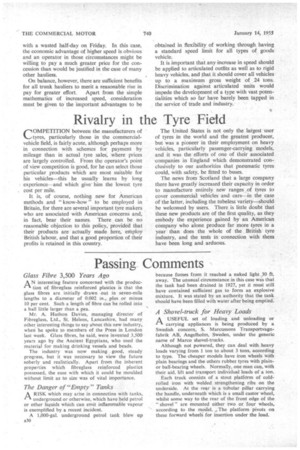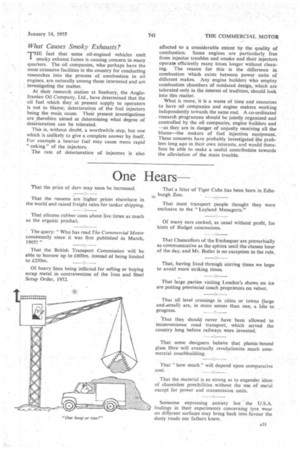Passing Comments
Page 32

Page 33

If you've noticed an error in this article please click here to report it so we can fix it.
Glass Fibre 3,500 Years Ago
A N interesting feature concerned with the produc
tion of fibreglass reinforced plastics is that the glass fibres are initially drawn out in seven-mile lengths to a diameter of 0.002 in., plus or minus 10 per cent. Such a length of fibre can be rolled into a ball little larger than a pea.
Mr. A. Hudson Davies, managing director of Fibreglass, Ltd., St. Helens, Lancashire, had many other interesting things to say about this new industry, when he spoke to members of the Press in London last week. Glass fibres, he said, were invented 3,500 years ago by the Ancient Egyptians, who used the material for making drinking vessels and beads.
The industry was now making . good, steady progress, but it was necessary to view the future soberly and realistically. Apart from the inherent properties which fibreglass reinforced plastics possessed, the ease with which it could be moulded without limit as to size was of vital importance.
The Danger of "Empty" Tanks
A RISK which may arise in connection with tanks, r-1 underground or otherwise, which have held petrol or other liquids which can emit inflammable vapour is exemplified by a recent incident.
A 1,000-gal, underground petrol tank blew up A30 because fumes from it reached a naked light ,30 ft. away. The unusual circumstance in this case was that the tank had been drained in 1927, yet it must still have contained sufficient gas to form an explosive mixture. It was stated by an authority that the tank should have been filled with water after being emptied.
A Shovel-truck for Heavy Loads
A USEFUL set of loading and unloading or
carrying appliances is being produced by a Swedish concern, S. Marcussons Transportvagnfabrik AB, Angelholm, Sweden, under the generic name of Marco shovel-trucks.
Although not powered, they can deal with heavy loads varying from 1 ton to about 3 tons, according to type. The cheaper models have iron wheels with plain bearings and the others rubber tyres with plainor ball-bearing wheels. Normally, one man can, with their aid, lift and transport individual loads of a ton.
Each truck consists of a stout platfOrm of coldrolled iron with welded, strengthening ribs on the underside. At the rear is a tubular pillar carrying the handle, underneath which is a small castor wheel, whilst some way to the rear of the front edge of the " shovel " are mounted either two or 'four wheels, according to the model. • The platform pivots on these forward wheels for insertion under the load. What Causes Smoky Exhausts?
riE fact that some oil-engined vehicles emit smoky exhaust fumes is causing concern in many quarters. The oil companies, who perhaps have the most extensive facilities in the country for conducting researches into the process of combustion in oil engines, are naturally among those interested and are investigating the matter.
At their research station at Sunbury, the AngloIranian Oil Company, Ltd., have determined that the oil fuel which they at present supply to operators is not to blame; deterioration of the fuel injectors being the main cause. Their present investigations are therefore aimed at determining what degree of deterioration can be tolerated.
This is, without doubt, a worthwhile step, but one which is unlikely to give a complete answer by itself. For example a heavier fuel may cause more rapid " coking " of the injectors.
The rate of deterioration of injectors is also affected to a considerable extent by the quality of combustion. Some engines are particularly free from injector troubles and smoke and their injectors operate efficiently many times longer without cleaning. The reason for this is the difference in combustion which exists between power units of different makes. Any engine builders who employ combustion chambers of outdated design, which are tolerated only in the interest of tradition, should look into this matter.
What is more, it is a waste of time and resources to have oil companies and engine makers working independently towards the same end. A co-ordinated research programme should be jointly organized and controlled by the oil companies, engine builders and —as they are in danger of unjustly receiving all the blame—the makers of fuel injection equipment. These concerns have probably investigated the problem long ago in their own interests, and would therefore be able to make a useful contribution towards the alleviation of the main trouble.
















































































































